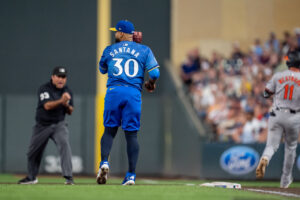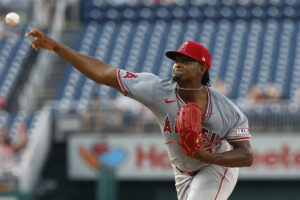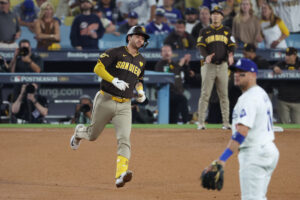The fireworks went off before the Atlanta sun had even set on Independence Day. Back and turning a new corner for the rallying Atlanta Braves, Freddie Freeman‘s position change is official.
The shocking speed with which he recovered from his broken wrist notwithstanding, the news of Freeman’s shift to third base to accommodate the hot-hitting Matt Adams has shocked or surprised many, even seasoned sportswriters like the Atlanta Journal Constitution’s Dave O’Brien. As he blazed through a rehab stint with Triple-A Gwinnett – starting at third base for just two games and flashing his glove at a position he hasn’t played regularly since high school – Freeman’s journey across the diamond has completed the transition from rumor mill fodder, to legitimate likelihood, to statistical and historical fact.
Freddie Freeman’s Position Change Supported by History
It’s not unheard of. Cal Ripken moved a few feet to his right from shortstop late in his career. Perennial All-Star and Good Guy Michael Young famously changed positions at the request of the Texas Rangers. And it’s hardly a new experience for the Braves to mull over whether their franchise player should play third base.
The last time the team was confronted with such a high-profile decision, it was the 2001 offseason. Future first-ballot Hall of Fame third baseman Chipper Jones departed the hot corner to accommodate former All-Star Vinny Castilla, who returned to the Braves (his first team after leaving Mexico) as a free agent after splitting a solid year by most metrics between the Tampa Bay Devil Rays and the National League’s Houston Astros (remember when?).
“I’ve carved my niche at third base and I certainly don’t feel this is a demotion,” he told the Augusta Chronicle in December 2001 after the signing. “Playing left [field] doesn’t bother me. I would love to play my whole career at one position, but I’m not going to let it stand in the way of us getting good players to help our ballclub. We’ve gone out and gotten a top-notch third baseman and I’ll move.”
Of course, the ascending Atlanta Braves of 2017 face different circumstances than the perennial champions of the 1990s. They also enjoy the benefit of consulting sabermetrics when making the decision. That means we also have the benefit of looking back to see if Jones’ position switch was a good idea.
While Jones was already an MVP, it wasn’t a terrible idea to snag one of the best third basemen on the market at the time, though Castilla’s best years in his 16-year career almost exclusively coincided with his time spent in the thin air of Colorado. In eight full seasons as a Rockie, Castilla hit 30+ homers six times (and 40 or more three times), drove in 100 or more runs five times and hit .300 or more four times. He never equaled any of those numbers in another uniform.
But the opportunity to move the production of a star hitter like Jones to the outfield (don’t you just love reminiscing on those Jones Boys outfields?) while adding an All-Star-caliber third baseman in Castilla to the lineup was too much to pass up for the Braves. They barely won the NL East by one and two games in 2000 and 2001, respectively, and featured. clinically anemic performances for several years in left field. They even allowed Bobby Bonilla – yes, that Bobby Bonilla – to play 63 games in left, to the tune of -1.1 WAR.
Did it work? The Braves didn’t lose a division crown for another two years after the experiment ended, so competitively, sure, it worked. In terms of WAR, however, it’s clear the hole in the lineup shifted from left field to third base.
WAR, Atlanta Braves Third Basemen, 1998-2004
| Year | Player | Games Played | WAR |
| 1998 | Chipper Jones | 158 | 7.1 WAR |
| 1999 | Chipper Jones | 156 | 7.3 WAR |
| 2000 | Chipper Jones | 152 | 6.0 WAR |
| 2001 | Chipper Jones | 159 | 6.1 WAR |
| 2002 | Vinny Castilla | 139 | -1.5 WAR |
| 2003 | Vinny Castilla | 147 | 1.9 WAR |
| 2004 | Mark DeRosa | 72 | -1.9 WAR |
| Chipper Jones | 96 | 3.3 WAR |
WAR, Atlanta Braves Left Fielders, 1998-2004
| Year | Player | Games Played | WAR |
| 1998 | Ryan Klesko | 120 | 2.8 WAR |
| 1999 | Gerald Williams | 120 | 1.9 WAR |
| 2000 | Reggie Sanders | 69 | 0.2 WAR |
| Bobby Bonilla | 63 | -1.1 WAR | |
| 2001 | B.J. Surhoff | 129 | 0.7 WAR |
| 2002 | Chipper Jones | 152 | 5.9 WAR |
| 2003 | Chipper Jones | 149 | 3.9 WAR |
| 2004 | Charles Thomas | 70 | 2.0 WAR |
| Eli Marrero | 47 | 1.7 WAR |
Castilla had the worst full-season WAR of his career – his entire 16-year career – in the first year of the experiment, at -1.5, a net 7.6 point drop from Chipper’s 5.9 WAR in 2001. He did, however, improve in 2003 to 1.9 WAR, while infusing some stability into the lineup courtesy of playing more games in both of his seasons in Atlanta than the Braves four primary left fielders before Chipper’s move. Chipper, in turn, carried his stability to left field, playing full seasons at high levels, with 5.9 and 3.9 WAR, respectively, before replacing Mark DeRosa as the primary third baseman in 2004.
Perhaps these stats are simply indicative of his gravity – is it fair to even make these comparisons? Yes, if the justification of uprooting your franchise player from his most familiar position is boosting your offense. Avoiding the distraction of shifting positions is part of why Young, who for years mastered the utility role, initially balked at the Rangers request to accommodate Elvis Andrus.
These numbers did represent declines for Chipper, and it’s arguable that, in addition to costing him some All-Star appearances, some of the leg injuries he sustained later in his career could have been related to playing a new, rangier position – one he had abandoned for third base after a season-ending injury in 1994. The shift also marred his career positional value. Though Chipper was not an elite fielder – he never won a Gold Glove – he was a decent fielder, averaging a 1.4 positional value and maintaining positive stats in this category every season in his career except those spent in left field, when he totaled a -14.2 positional value (seasonal average of -4.73).
Regardless, Castilla went back to Colorado as a free agent after 2003, and Chipper returned to the playoffs multiple times and even reinvented himself late in his career, winning a batting title in 2008 at age 36.
So, what does this mean, if anything, for Freeman and Adams, a player acquired with far less risk than Castilla was by a Braves team with slightly more desperation than their 2001 counterparts? Freeman’s return is drastically ahead of schedule and, interestingly, the Braves have made up ground in both the NL East and Wild Card races. While a postseason appearance would be a pleasant surprise, it’s not totally out of the cards.
Adams’ six-year total of 5.0 WAR doesn’t come close to Freeman’s eight-season line of 23.4, but that’s probably not fair, as we honestly don’t have a reliable sample size from Adams’ career. He hasn’t played with enough regularity. This season, now playing every day, Adams was actually 21st in the league among first basemen, just under 1.0 WAR coming into the July 4 tilt with the Astros, while the two-time All-Star Freeman is still fourth in the league at 2.6 WAR, despite spending weeks on the DL (neither has enough plate appearances to qualify for the league lead).
A balance must be drawn in modern baseball by exploiting the value of data and sabermetrics while acknowledging the value of the traditional “eyeball test” – if a player is hot, keep him in the lineup.
For Adams, this may be the big break he needs to cement everyday status and showcase his value against both right- and left-handed pitchers. Atlanta is willing to make moves to get him at-bats. He’s on pace to set career-highs in multiple offensive categories, is by all public reports a good fit in the clubhouse, and is performing at a high level, helping bring Atlanta back to playing .500 ball. Freeman, though, was raking before his injury, continuing his stellar production from 2016. He is also unarguably the most important player on the Braves roster. He must play, and he will hit.
The Braves will not mortgage Freeman’s long-term health and ability for a novelty experiment with Adams, who’s eligible for his last year of arbitration in 2018, in a year they’ll be hard-pressed to catch the Washington Nationals or any of the Wild Card contenders in the NL West. Yet, the allure of drawing out Adams’ full potential is intriguing, and the transition is definitely happening (to the delight of Freeman’s fantasy owners). It’s a creative solution to a good problem to have.
The Braves have signed off on Freeman’s quick rehab and recovery, and have given the player tremendous latitude on his own future and the team’s present-day lineup. Still, their review of Freeman’s ability to play third base must be exhaustive and belabored, with a short leash on this experiment should it prove too risky or should Adams’ production falter.
There’s no statistically significant measurement of a baseball player’s willingness to support his team’s best interests, but Freeman’s offer to man the hot corner instantly puts him among the league leaders in that category.
* All statistics courtesy of FanGraphs.
Main Photo:






